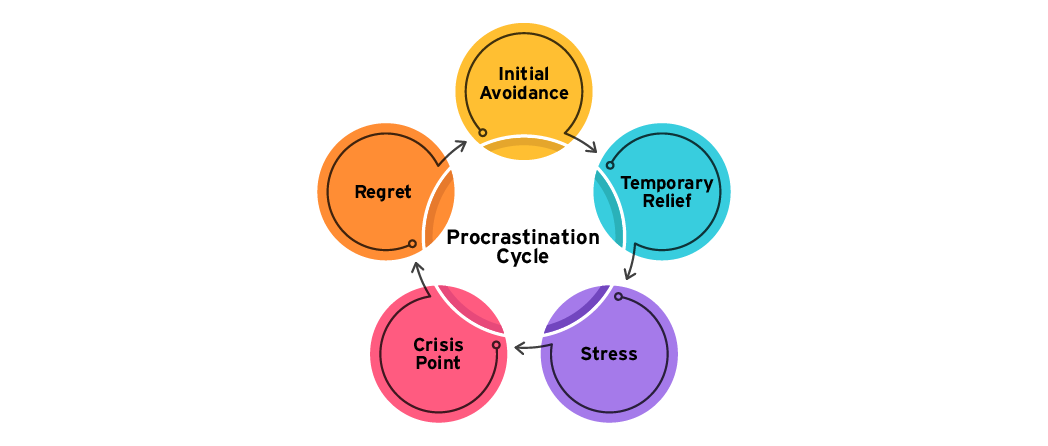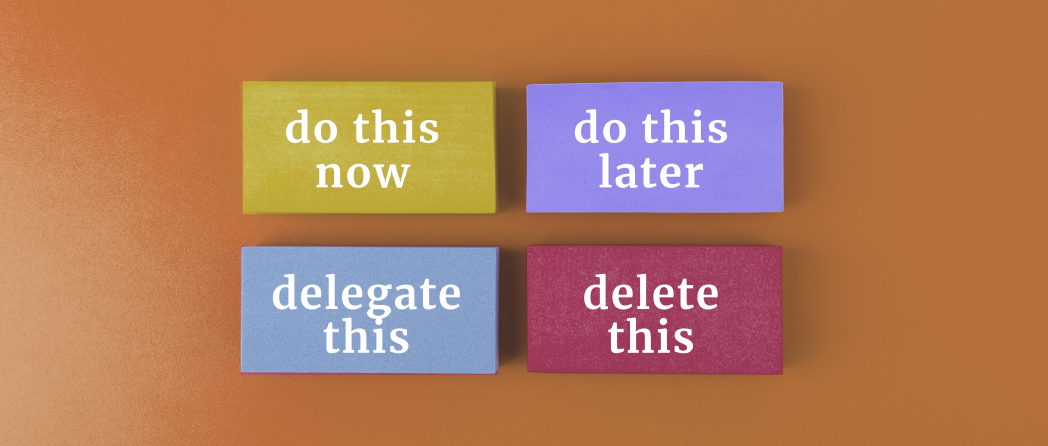Oftentimes we talk about procrastination like it’s just a laughable quirk of the human condition, but for many, it can negatively impact self-esteem or general well-being. Luckily however, there are techniques to not just deal with, but to overcome procrastination — techniques that suit your personality type, your lifestyle, and the type of work you’re doing.
Your Archetype — a personality model based on the work of psychiatrist Carl Jung — is a wonderful way to gain insight into your behavior and the motivations behind them. We used this model to help you identify how your procrastination might manifest and ways to overcome it based on your type. If you don’t yet know your type, check out TerraYou’s free test to find out.
Understanding the procrastination cycle is crucial to finding the techniques that work for you. Procrastination isn’t the same as laziness! Rather, it’s a way for the brain to cope with situations that are unpleasant in a variety of ways.
Understanding the procrastination cycle
Procrastination follows an all-too-familiar pattern when it strikes, broken down into several phases.
Step 1: Procrastination starts with the initial avoidance of the task. Be it because of fear, overwhelm, not being in the right headspace, or any other reason.
Step 2: This leads to a temporary feeling of relief. In the moment, we feel good since we no longer need to deal with this task.
Step 3: The next step is anxiety or stress now that the task seems even more impossible to complete than before. This can be intensified by additional or unrelated tasks having piled up in the meantime.
Step 4: This is the crisis point, when the task can no longer be avoided, and we must tackle it in a panicked state. For many, this compromises the quality of the work.
Step 5: Finally, we feel shame for having procrastinated the project and/or for the dip in quality, causing us to regret our behavior or our tendency to procrastinate in the first place.

Using your archetype to your benefit
The good news about the ubiquitousness of procrastination is that there are many resources available to manage it. Since your archetype can hold the key to the “why” behind your actions, it’s a perfectly suited lens through which to examine procrastination. The twelve types and their techniques are:
The Caregiver
Since you often prefer clear-cut, solution-based work, a technique for overcoming procrastination could be turning to time management techniques. One example is the Pomodoro technique, when you work in 25-minute increments, followed by a five-minute break when you do something not related to the task. Feel free to repeat this cycle 4-5 times, optionally extending the work time or the break time. This is great for helping get into the zone by creating start and stop boundaries around the work. Another option would be to structure your work using an Eisenhower Box to help you determine which tasks you should tackle and in which order.

The Creator
You have the tendency to be your own harshest critic, so rather than allowing yourself to sink into the shame often associated with procrastination, your technique tackles distraction. Identify what specifically distracts you in these moments. Perhaps you always get up to get a drink of water. Or you find yourself stopping often to fetch missing office supplies. Once you know what your pitfalls are, build a workspace that allows you to relax into your work. Prepare your water or create a work area where all office supplies are one chair-swivel away. If your phone is your biggest distraction but putting it on Do Not Disturb isn’t an option, put it in a drawer on the other side of the room. You’ll still hear it ring, but you’ll have to go out of your way to pick it up.

The Everyman
You have excellent work ethic, which is why your technique is to use positive peer pressure to your advantage! The communities you’ve formed are full of people who are ready to support you, so have someone nearby to keep you accountable. Using your communities to your advantage also functions as a support system where you can reach out to others and share your struggles with procrastination. Yes, these people can check in on you to make sure you’re sticking to your goals, but even more importantly, they can cheer you on as you push forward and can celebrate with you after you’ve accomplished what you set out to do.
The Explorer
Learning to temper your impulsiveness by thinking ahead is important for your type, which is why your technique is making time for intentional reflection followed by structuring your day around what you’ve found. For example, ask yourself during which times of day you struggle with procrastination the most — just as importantly, during which ones are you most productive? Do you find it easier to focus in the morning? After you’ve eaten something in the afternoon? Schedule your most intensive or difficult tasks for peak times and do the same for mundane tasks by taking care of those during phases when it’s difficult to focus.

The Hero
Your type benefits from learning to be vulnerable and running with the help you’re offered, which is why the following tip can help you: start with small changes using the 2-minute Rule. The rule is simple: if a task will take you 2 minutes or less, do it right now. Wash that mug, tidy your workspace, whatever it may be: if it’s quick, tackle it right away! This gives you the instant gratification of having done something on your list, but doubles as a protective measure to prevent tasks from building up — which makes it easier to overcome procrastination at the next, possibly bigger step.
The Innocent
Your relentless optimism can help you overcome procrastination! Make the effort of extending the goodwill you direct toward others, toward yourself. Because the procrastination cycle revolves around shame about being unable move past your struggles, start by forgiving yourself for procrastinating, now and in the past. Procrastination is a coping mechanism, not a lack of desire to get things done. Then move on to breaking your projects into smaller tasks, and after each sub-task, plan in a reward for yourself. Even if it’s something small like getting a yummy coffee, celebrating the little wins can give you the motivation you need to get started (and the momentum to keep going) when you have a tangible reward to work toward.

The Jester
Your type can achieve a sustainable balance between your rule breaker tendencies and the need to get things done by both reframing the way you think about your tasks and how you talk to yourself about them. Rather than saying “I have to scrub the shower”, say “I deserve to live in a space that is clean and comfortable”. These things are certainly true, but even further, making the conscious choice to remind yourself of that fact can help break the cycle of anxiety and shame that feeds procrastination. This also serves to give control of the situation back to you by noting the reasons you value the completion of this task.
The Lover
Since you’re particularly skilled in growing after quiet reflection, practice self-love by using the technique of planning your next day in advance. This is more than making a simple reminder for yourself of what you need to do tomorrow. Rather, think through the following three points: 1. What must be done, 2. What would be nice to have done, and 3. How long does each task take and what are their deadlines. This technique is particularly beneficial because it keeps your procrastination at bay before it has the chance to take hold once the new day has begun.

The Magician
You thrive under discipline and have the unique skill of being able to focus in on a goal once it’s been set — the perfect tool to defeat procrastination. You’re perfectly positioned to be a master of playing the long game; procrastination is often fed by a lack of (visible) short-term rewards, so make a dedicated effort to identify the long-term goals and the positive consequences coming your way once you’ve reached them. Perhaps this task matters because it helps your team organize an incredible event. And that same event is something you can bring up in your next performance review and get the promotion you’ve been waiting for. Writing these goals down can help, especially somewhere you can be reminded of them often, like a sticky note on your mirror.
The Rebel
Since your temperament is perfectly suited to break patterns, push through procrastination by reducing the number of decisions you need to make during the day, whether big or small. Each decision you make uses brain capacity, so even if you spare yourself a small expenditure, you can save that for another task with a bigger impact. Decide (and prepare) in advance as much as you can. For example, know the day before what you’re going to wear, what you’ll have for breakfast, or whether you or your partner will pick up the kids from school.

The Ruler
When you apply yourself to something, you’ll work tirelessly to achieve it, regardless of the topic, so apply yourself to overcoming your procrastination by starting your day “Eating a Frog”. This technique comes from Mark Twain, who is credited to have said, “Eat a live frog first thing in the morning and nothing worse will happen to you the rest of the day.” Eat your frog (aka: do your most dreaded task) by taking a deep breath and tackling it first thing. Applying this technique not only gets the task out of the way, but the feeling of accomplishment that comes afterward can help you ride that momentum right into your next project for the day.
The Sage
Your deep-thinker tendencies may make you more likely to procrastinate by, for example, waiting until you’re fully informed before starting a task. To address this hurdle, try a technique used by many in professional spheres, called the “70% Rule”. This rule claims that you should never wait until you know everything about a topic, rather, get started when you know around 70% of what is required. For someone like you who knows the value of knowledge, this can be a difficult technique to adopt, but once successfully mastered it, it will prevent you from starting a task too late or losing momentum once you’ve started.

Break the cycle
Breaking the procrastination cycle is very possible once you’ve tapped into your individual tendencies and habits.

Finding the best technique for you to overcome it is often trial and error, so don’t give up if your first attempt doesn’t work out like you hoped. By harnessing the Archetype Personality Model and looking deeper into your motivations for procrastinating, you can understand yourself on a new level and take yet another step toward self-development.
If you’ve procrastinated in the past, that doesn’t mean you’re doomed to do so forever. By being forgiving of yourself and continuing to move forward with intention, your habits can change, making procrastination a thing of the past.



